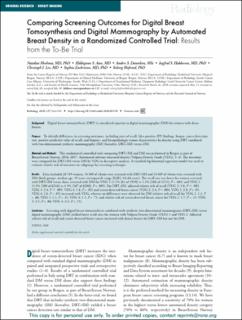| dc.contributor.author | Moshina, Nataliia | |
| dc.contributor.author | Aase, Hildegunn Siv | |
| dc.contributor.author | Danielsen, Anders Skyrud | |
| dc.contributor.author | Haldorsen, Ingfrid S. | |
| dc.contributor.author | Lee, Christoph I. | |
| dc.contributor.author | Zackrisson, Sophia | |
| dc.contributor.author | Hofvind, Solveig | |
| dc.date.accessioned | 2021-07-07T08:45:53Z | |
| dc.date.available | 2021-07-07T08:45:53Z | |
| dc.date.created | 2021-01-20T19:53:04Z | |
| dc.date.issued | 2020 | |
| dc.Published | Radiology. 2020, 297 (3), 522-531. | |
| dc.identifier.issn | 0033-8419 | |
| dc.identifier.uri | https://hdl.handle.net/11250/2763673 | |
| dc.description.abstract | Background: Digital breast tomosynthesis (DBT) is considered superior to digital mammography (DM) for women with dense breasts.
Purpose: To identify differences in screening outcomes, including rates of recall, false-positive (FP) findings, biopsy, cancer detection rate, positive predictive value of recalls and biopsies, and histopathologic tumor characteristics by density using DBT combined with two-dimensional synthetic mammography (SM) (hereafter, DBT+SM) versus DM.
Materials and Methods: This randomized controlled trial comparing DBT+SM and DM was performed in Bergen as part of BreastScreen Norway, 2016–2017. Automated software measured density (Volpara Density Grade [VDG], 1–4). The outcomes were compared for DBT+SM versus DM by VDG in descriptive analyses. A stratified log-binomial regression model was used to estimate relative risk of outcomes in subgroups by screening technique.
Results: Data included 28 749 women, 14 380 of whom were screened with DBT+SM and 14 369 of whom were screened with DM (both groups: median age, 59 years; interquartile range [IQR], 54–64 years). The recall rate was lower for women screened with DBT+SM versus those screened with DM for VDG 1 (2.1% [81 of 3929] vs 3.3% [106 of 3212]; P = .001) and VDG 2 (3.2% [200 of 6216] vs 4.3% [267 of 6280]; P = .002). For DBT+SM, adjusted relative risk of recall (VDG 2: 1.8; P < .001; VDG 3: 2.4; P < .001; VDG 4: 1.8; P = .02) and screen-detected breast cancer (VDG 2: 2.4; P = .004; VDG 3: 2.8; P = .01; VDG 4: 2.8; P = .05) increased with VDG, whereas no differences were observed for DM (relative risk of recall for VDG 2: 1.3; P = .06; VDG 3: 1.1; P = .41; VDG 4: 1.1; P = .71; and relative risk of screen-detected breast cancer for VDG 2: 1.7; P = .13; VDG 3: 2.1; P = .06; VDG 4: 2.2; P = .15).
Conclusion: Screening with digital breast tomosynthesis combined with synthetic two-dimensional mammograms (DBT+SM) versus digital mammography (DM) yielded lower recall rates for women with Volpara Density Grade (VDG) 1 and VDG 2. Adjusted relative risk of recall and screen-detected breast cancer increased with denser breasts for DBT+SM but not for DM. | en_US |
| dc.language.iso | eng | en_US |
| dc.publisher | Radiological Society of North America | en_US |
| dc.rights | Attribution-NonCommercial-NoDerivatives 4.0 Internasjonal | * |
| dc.rights.uri | http://creativecommons.org/licenses/by-nc-nd/4.0/deed.no | * |
| dc.title | Comparing screening outcomes for digital breast tomosynthesis and digital mammography by automated breast density in a randomized controlled trial: Results from the to-be trial | en_US |
| dc.type | Journal article | en_US |
| dc.type | Peer reviewed | en_US |
| dc.description.version | publishedVersion | en_US |
| dc.rights.holder | Copyright Radiological Society of North America | en_US |
| cristin.ispublished | true | |
| cristin.fulltext | original | |
| cristin.qualitycode | 2 | |
| dc.identifier.doi | 10.1148/radiol.2020201150 | |
| dc.identifier.cristin | 1875998 | |
| dc.source.journal | Radiology | en_US |
| dc.source.40 | 297 | |
| dc.source.14 | 3 | |
| dc.source.pagenumber | 522-531 | en_US |
| dc.identifier.citation | Radiology. 2020, 297, 522–531. | en_US |
| dc.source.volume | 297 | en_US |

